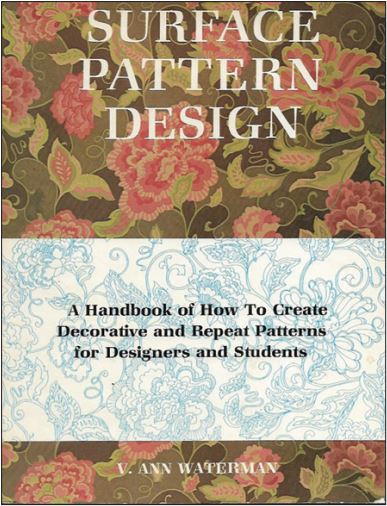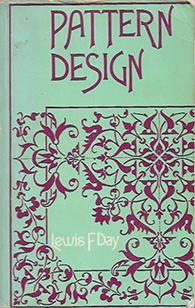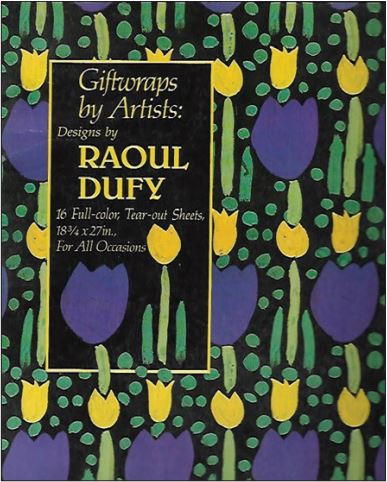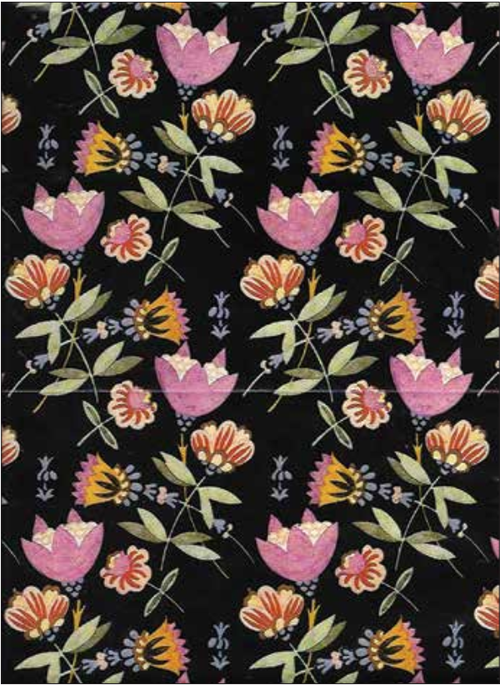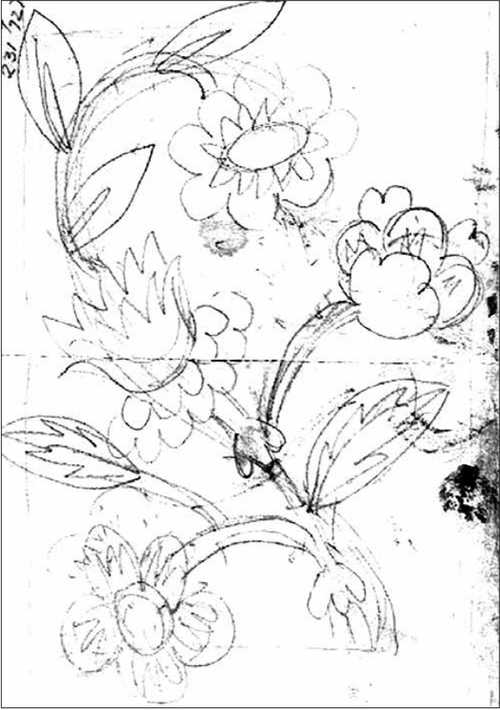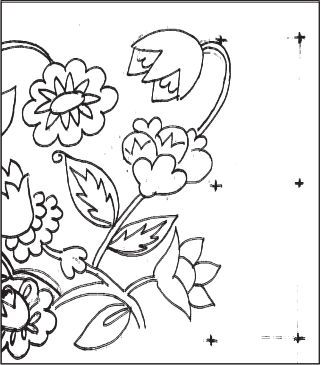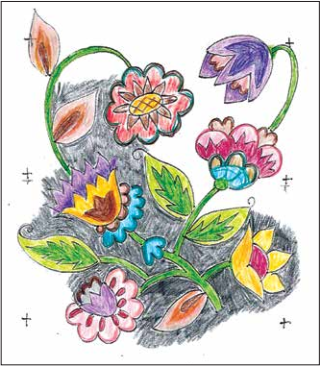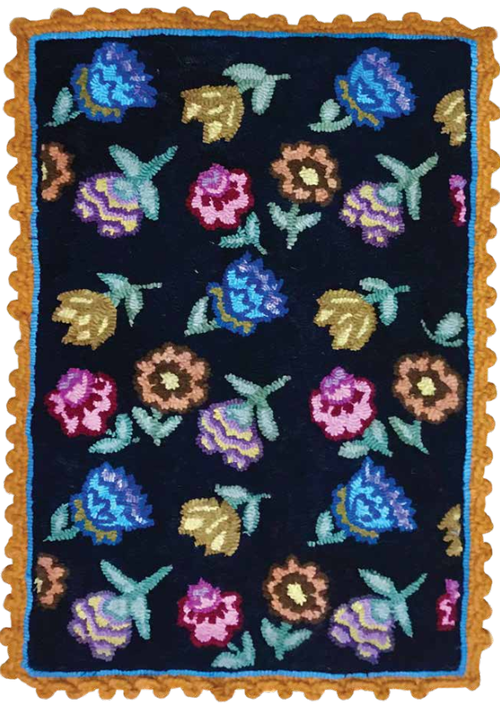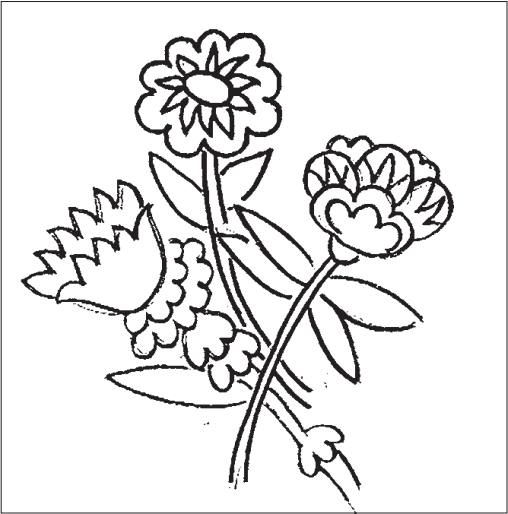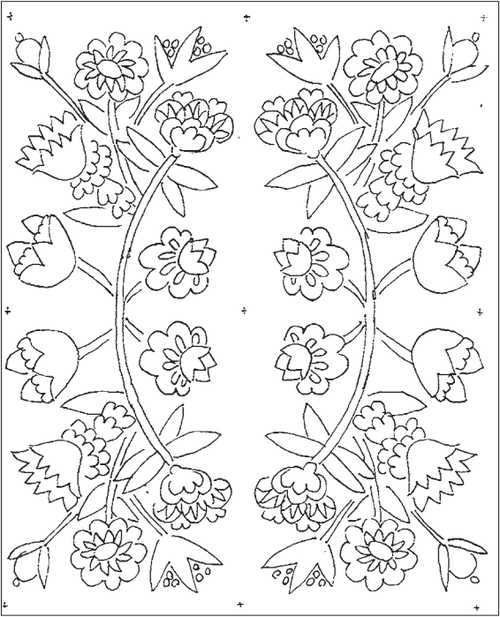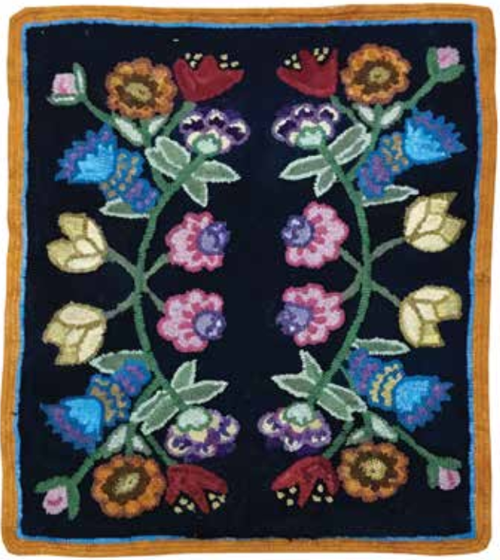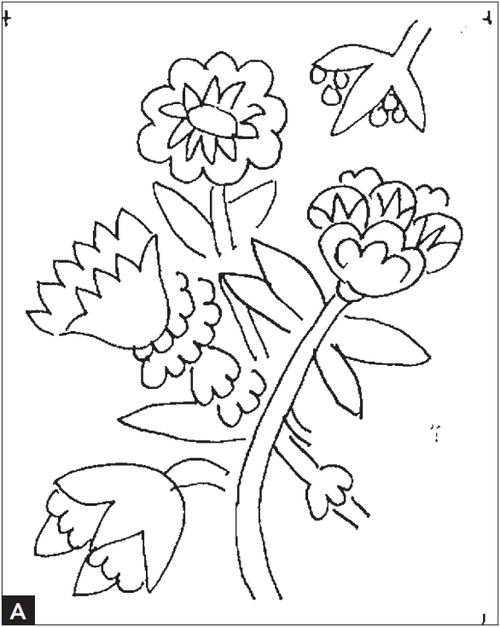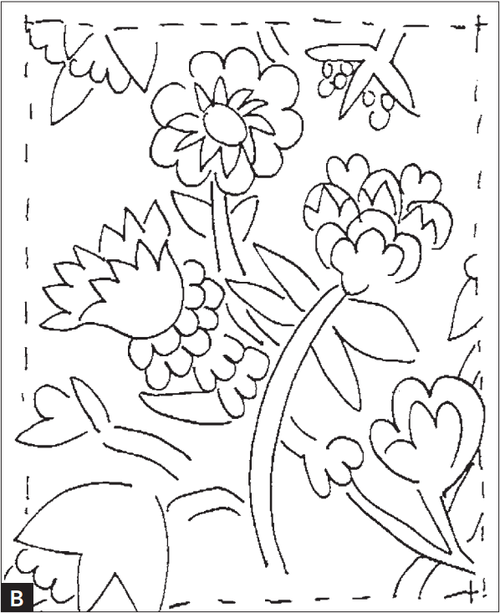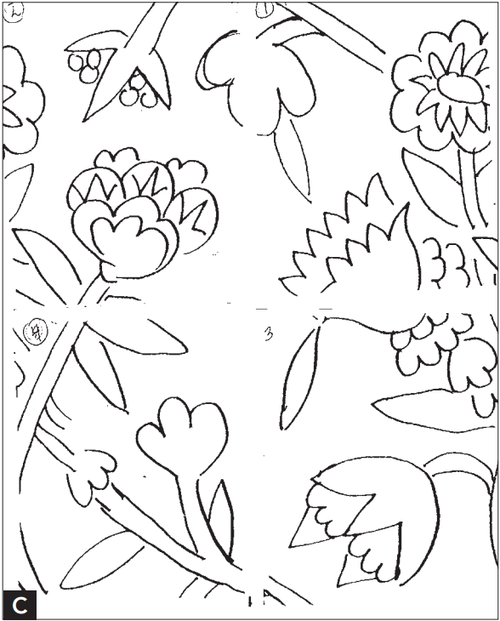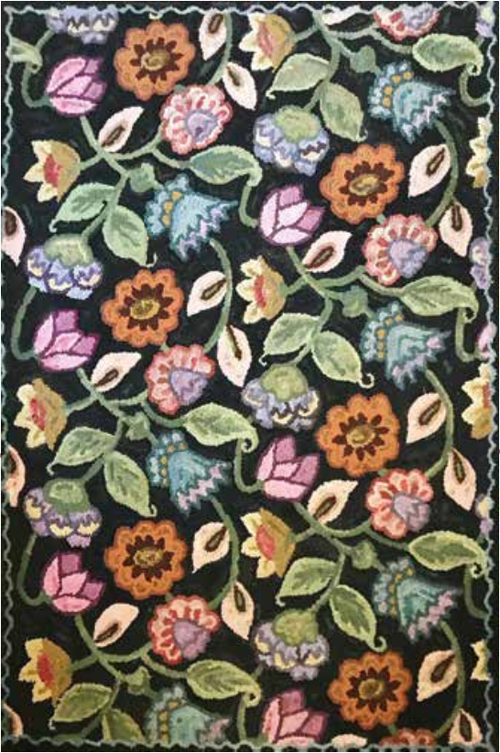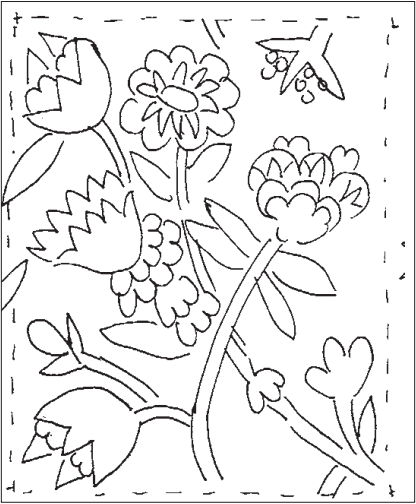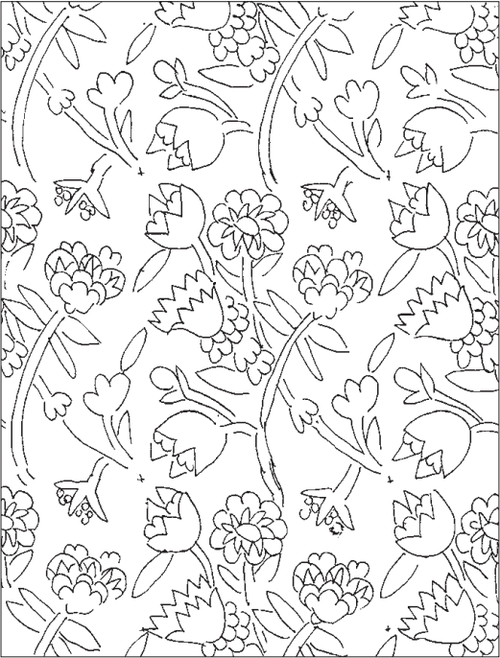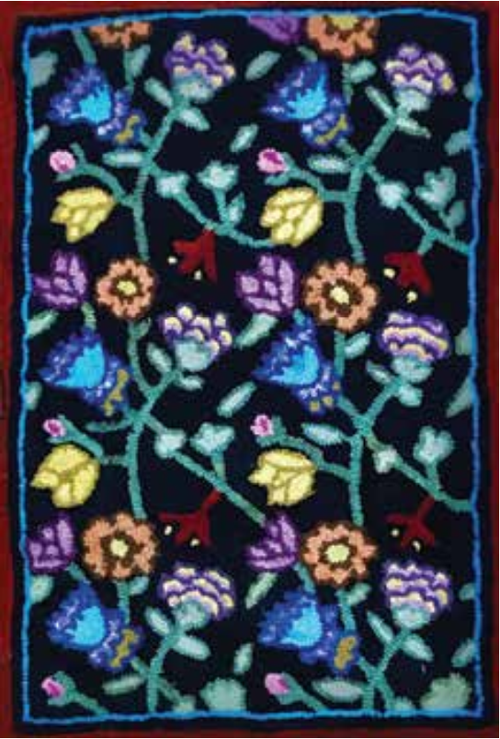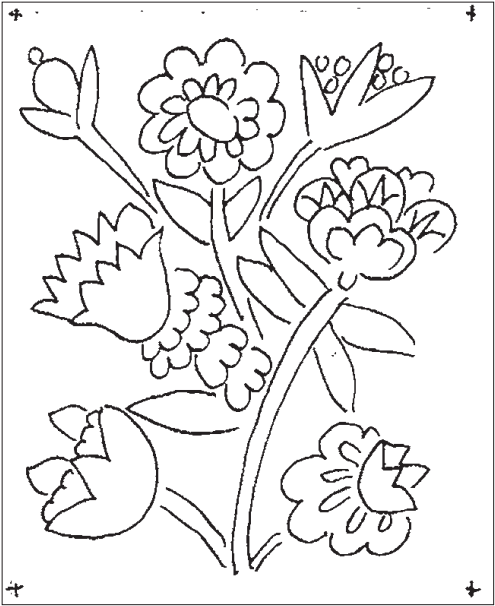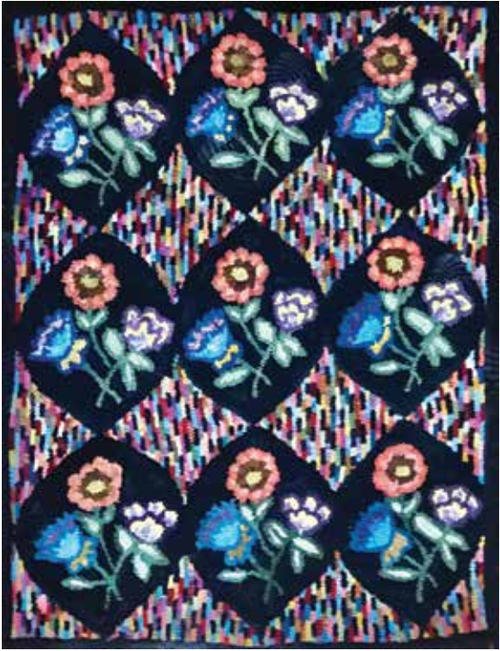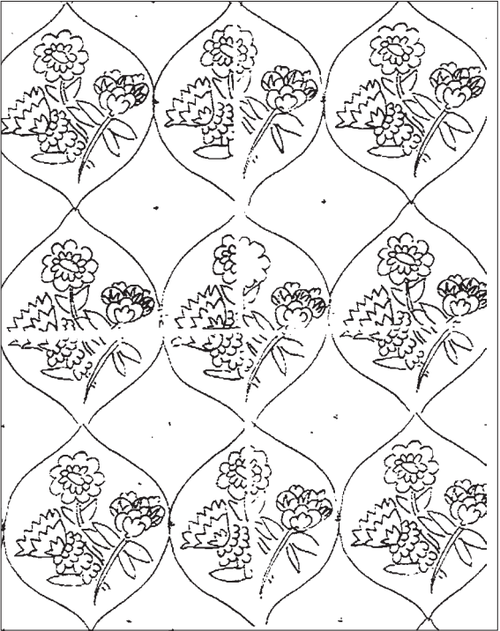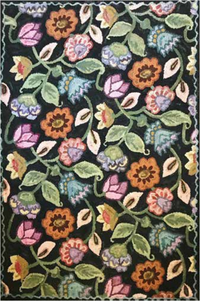A Journey of Forty Years
Creating Pattern Repeats for Rug Hooking Design

Half-Drop Repeat, 5' x 7', #10-cut wool on linen with a simple whipped edge.
My interest in patterns that repeat is closely aligned to my interest in ceramic tiling—the mathematical arranging of identical shapes so that they completely cover an area without overlapping.
My degree in “Craft” (a nod to my parents who underwrote this educational path in the 1970s!) prepared me for
a profession in ceramics. I left the
University of Illinois with a copy of Lewis F. Day’s Pattern Design packed in my trunk—I anticipated the rainy day when I might unravel the mysteries of the “composition and development of floral and geometric forms” that Day promised in the introduction. (For those readers who are interested in acquiring
a copy, look for the Dover reprint.)
Forty-some years later that rainy day arrived, and I set out to discover the “construction, expansion, and
application of a whole spectrum of design problems.”
Lewis Day was a contemporary and friend of Walter Crane and William Morris and was a leading figure in the British Arts and Crafts movement during the end of the 19th century. He first outlined the construction of pattern repeat in 1887 in his small volume Anatomy of Pattern, and in the 1903 revision, he “improved” the text from the original to the “fewest and plainest words” and with diagrams which were “simpler and more self-explanatory.”
Oh boy! Victorian English a century later was still pretty difficult to decode, despite Day’s efforts to be plainer and simpler. He writes, “It is, practically speaking, inevitable that the lines shall in the end assert themselves in repeated pattern; if the artist does not arrange for them in his design, they fall as may happen; it is therefore the merest precaution of common-sense on his part to lay them down from the beginning.” Overwhelmed, I wondered if there was a 20th century textbook that was more “self-explanatory.”
I decided to call my rug- hooking friend Kate Porter, an excellent fabric designer from the Cleveland area. (She designed the wonderful mobius scarf that many of us received from the ATHA Biennial in 2016.) Kate graduated from the prestigious College of Visual and Performing Arts at Syracuse University, and I asked her if there was a 20th-century text that she may have used in college. To my profound delight, she affirmed that one of her professors at Syracuse, V. Ann Waterman, had published such a book that would be easier for me to use. I promptly purchased a copy of the book on Amazon: Surface Pattern Design: A Handbook of How to Create Decorative and Repeat Patterns for Designers and Students.
Published in 1984, Ms. Waterman references Day’s contributions and lays out the graphing of pattern repeats in a straightforward manner. I am fully aware that professional 21st-century pattern
designers are using digital programs to design everything from wallpaper,
apparel goods, and dinnerware, to laminates, floor tile, and carpeting. But as a craftsperson, as an artisan, and as a rug hooker, I still wanted to know how my forebearers figured out how to create repeats without the use of advanced technology.
I have admired, collected, and used fabrics for most of my adult life. I can recognize and identify many of the basic pattern repeats: spot toss, diamond, block, brick, turnover, ogee, and the most elusive to me, the half-drop repeat. I thought that it would be fun to take one set of floral motifs and map them out using Ann’s text as a guide to create five different rugs, using similar color plans to describe the geometry in each of the pieces.
First, however, I needed to design my motifs. I chose to adapt a pattern originally designed by one of my favorite artists, Raoul Dufy. Dufy, was a French painter, draftsman, stage decorator, block printer, ceramicist, and fabric designer. Working in Europe at the turn of the 19th century, he “turned his attention to patterning to earn money.” Like his contemporaries at the Bauhaus and the Vienna Werkstatte, he “blurred the distinction between fine and applied arts” and saw no shame in designing for industry.
I own Giftwraps by Artists, a book of wrapping paper with designs by Raoul Dufy, published by Abrams in the 1980s. The gift wraps in the portfolio are
“reduced in scale and directly photographed from the original designs on paper” from the collection owned by Bianchini-Ferier, for whom Dufy worked between 1912 and 1930. In all, Dufy designed over 1,500 fabrics for them. His patterns are “the basis for much of the modern Western popular and commercial cloth design.” I was particularly fond of one design, and I adapted it for my croquis, or sketch, from which I developed my patterns.
Narrowing down the possibilities for the geometric pattern repeats, I chose five: spot toss, the ogee, the square side
repeat, the turnover, and the half-drop repeat. On graph paper grid, I made registration marks and mapped out each
of the pattern repeats to those which I wished to explore.
Then, I began to hook.
Additional Images
-
My favorite gift wrap from Dufy’s book
-
My interpretive adaptive sketch from Dufy’s pattern
The Spot Toss
The spot toss is a pattern in which the elements of the design appear to float in a negative space and do not connect with one another. The patterns can be easily achieved by “triangulating the motifs” to keep an even distance and balance between them. They can be either directional or non-directional. I used five of the floral motifs in the spot toss, which I cut out and moved around on the grid. When I found a pleasing arrangement, I traced them and repeated them into a larger array or “diaper.”
-
Refined croquis
-
I used the initial croquis to also sketch out the color plan for the five rugs.
-
Spot Toss Repeat, 18" x 26", #6-cut wool on linen. Picot edge treatment.
The Turnover Repeat
This rug is a turnover or mirror repeat. I mirrored the motif vertically and then flipped that half of the repeat over. Had I rotated each one on the center axis in a clockwise or counterclockwise direction, I would have created a pattern know as a turnround. Turnrounds are often found in scarf designs, tile decoration, and block printing, and can be created with rectangular, square, or diamond shapes. This turnover was hooked in a #8 cut.
-
Turnover Repeat, 29" x 32", #8-cut wool on linen, single crochet edge as border.
The Half-Drop Repeat:
This is the most complicated repeat of all. These patterns are the most interesting to me, as there is a bit of magic in the designing. Half-drop patterns have to be “proofed,” as they continue into the negative space between the repeats as the “drop” halfway down the side of the repeat. By cutting the fnished motif into four equal sections and rearranging those sections, it is possible to add the connecting leaves and veins to have an all-over pattern which drops slightly on a diagonal and appears to go on forever.
-
A. The proofng requires creating a croquis where elements of the motif extend outside of the border.
-
B. Negative areas are flled in with additional elements.
-
C. This croquis is then cut into four equal sections. Labeleach section in the upper left-hand corner (1, 2, 3, and 4), tomake it possible to rearrange the sections to “proof” the design.(2,1,4,3), (3,4,1,2), (4,3,2,1), (2,3,4,1) and (4,1,2,3) are all possible combinations. Shown here is (2,1,4,3).
-
D. When I confgured and tweaked the combinations, this resulting pattern emerged
-
Half-Drop Repeat, 5' x 7', #10-cut wool on linen with a simple whipped edge.
The Square Repeat:
These “block” patterns (square, rectangular, or diamond) are single units and can create larger repeating patterns when placed side by side, with the corners of the pattern meeting in a square. It can be repeated in either direction numerous times. Depending on the enlargement and the cut, it can be an easy method of creating large area rugs. The rug has two half repeats in length and two full repeats in width.
-
Square Repeat, 18" x 26", #6-cut wool on linen, simple whipped edge in red.
The Ogee:
The ogee is structured from the diamond. This rug was an opportunity to play with the shape, and to differentiate between the motifs with some lively hit-andmiss striping. The motif repeats three times in either direction; because of the lozenge shape it shows best in a vertical arrangement.
-
Ogee Repeat, 26" x 35", #8-cut wool on linen, simple whipped edge.
I take great pleasure in studying masterwork and learning centuries later from their example. In doing so, I am able to study time, technique, history, and aesthetics. In the words of French essayist Marcel Brion, “There is greatness in accepting one’s limitations, and virtue in knowing and fulflling those limitations to the utmost of one’s capacity.”
While my five rug patterns may not be representative of my favorite personal work, I value the experience I had learning how to make them. This is especially true when it takes 40 years to arrive at the “rainy day.” I am so grateful to have had the grace of both time and health.
Maddy Fraioli is an Oxford and McGown Certified teaching instructor and maintains ceramic and fiber arts studios in Roseville, Ohio. Her work may be found at www.rosehilldesign.com, www.rosehilldesign.com
References:
Special thanks to Lewis F. Day, Raoul Dufy, and V. Ann Waterman for sharing the gifts of pattern design and inspiration for future generations to continue to explore.
Patten Design, Lewis F. Day
Surface Pattern Design, V. Ann Waterman
Giftwraps by Artists, Designs by Roaul Dufy; Harry Abrams,
Publisher


